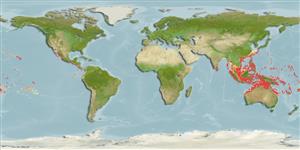Common names from other countries
>
Mulliformes (Goatfishes) >
Mullidae (Goatfishes)
Etymology: Parupeneus: Latin, parum, parvum = small + Peneus, the name of a river.
More on author: Bleeker.
Environment: milieu / climate zone / depth range / distribution range
Ökologie
seewasser riff-verbunden; tiefenbereich 1 - 100 m (Ref. 43239). Tropical; 30°N - 25°S
Western Pacific: Moluccas and Philippines to western Samoa, north to the Ryukyu Islands, south to New Caledonia and Tonga; Palau, Caroline and Marshall Islands in Micronesia. Recorded from Shark Bay, Western Australia (Ref. 115274).
Size / Gewicht / Alter
Maturity: Lm ? range ? - ? cm
Max length : 30.0 cm TL Männchen/unbestimmt; (Ref. 9710); common length : 20.0 cm TL Männchen/unbestimmt; (Ref. 48636)
Rückenflossenstacheln (insgesamt): 8; Rückenflossenweichstrahlen (insgesamt): 9; Afterflossenstacheln 1; Afterflossenweichstrahlen: 7. Diagnosis: Pectoral rays 15-16 (usually 15). Gill rakers 6-8 + 20-25 (total 28-32). Body moderately elongate, depth 3.2-3.5 in SL; head length 2.75-3.15 in SL; snout length 1.8-2.0 in HL; barbel length 1.3-1.5 in HL; head and anterior half of body reddish black, posterior half white and yellow with a black spot nearly as large as eye on upper side below rear base of second dorsal fin, followed by small blue spots; a white band from front of snout passing above eye along dorsal part of body, and a second nearly parallel one from corner of mouth to above pectoral fin; caudal fin pale yellow with a broad, dusky lower margin, and often with a small red spot at midbase; barbels red (Ref. 54393).
Adults solitary, juveniles in schools (Ref. 90102). Usually found in the vicinity of coral reefs in protected waters such as bays or lagoons or in deeper outer-reef areas to at least 40 meters (Ref. 54393). Inhabits mixed sand, rubble, and seaweed covered bottoms near coral reefs. Carnivorous, feeds mainly on worms, crustaceans, brittle stars, and small mollusks and heart urchins.
Life cycle and mating behavior
Geschlechtsreife | Fortpflanzung | Ablaichen | Eier | Fecundity | Larven
Randall, J.E., 2004. Revision of the goatfish genus Parupeneus (Perciformes: Mullidae), with descriptions of two new species. Indo-Pac. Fish. (36):64 p. (Ref. 54393)
IUCN Rote Liste Status (Ref. 130435)
CITES (Ref. 128078)
Not Evaluated
Bedrohung für Menschen
Harmless
Nutzung durch Menschen
Fischereien: kommerziell; Aquarium: Kommerziell
Mehr Information
NamenSynonymeMetabolismusRäuberÖkotoxikologieFortpflanzungGeschlechtsreifeAblaichenFecundityEierEientwicklung
ReferenzenAquakulturAquakultur ProfilZuchtlinienGenetikElectrophoresesVererbbarkeitKrankheitenVerarbeitungMass conversion
PartnerBilderStamps, Coins Misc.LauteCiguateraGeschwindigkeitSchwimmstilKiemenoberflächeOtolithsGehirngrößeSehfähigkeit
Tools
Zusatzinformationen
Download XML
Internet Quellen
Estimates based on models
Preferred temperature (Ref.
115969): 24.7 - 28.9, mean 27.6 (based on 732 cells).
Phylogenetic diversity index (Ref.
82804): PD
50 = 0.5000 [Uniqueness, from 0.5 = low to 2.0 = high].
Bayesian length-weight: a=0.01380 (0.00789 - 0.02416), b=3.13 (2.99 - 3.27), in cm Total Length, based on LWR estimates for this species & Genus-body shape (Ref.
93245).
Trophic level (Ref.
69278): 3.4 ±0.39 se; based on food items.
Widerstandsfähigkeit (Ref.
120179): mittel, Verdopplung der Population dauert 1,4 - 4,4 Jahre. (Preliminary K or Fecundity.).
Fishing Vulnerability (Ref.
59153): Low vulnerability (20 of 100).
